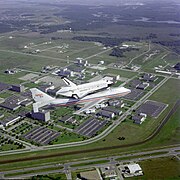Johnson Space Center
Lyndon B. Johnson Space Center | |
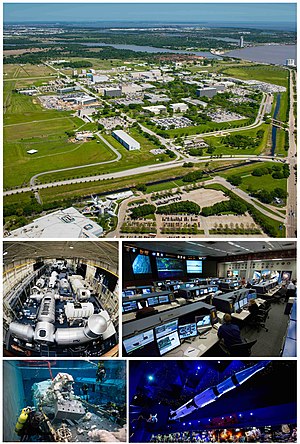 Top to bottom, left to right: Aerial view of JSC with Space Center Houston in the foreground, Space Vehicle Mockup Facility, Christopher C. Kraft Jr. Mission Control Center, Neutral Buoyancy Laboratory, and the Space Center Houston Saturn V exhibit. | |
| Abbreviation | JSC |
|---|---|
| Predecessor | Space Task Group |
| Formation | November 1, 1961[1] |
| Location | |
| Owner | NASA |
Director | Vanessa E. Wyche |
| Staff | 3,200 civil service |
| Website | JSC home page |
Formerly called | Manned Spacecraft Center |
The Lyndon B. Johnson Space Center (JSC) is NASA's center for human spaceflight in Houston, Texas (originally named the Manned Spacecraft Center), where human spaceflight training, research, and flight control are conducted. It was renamed in honor of the late U.S. president and Texas native, Lyndon B. Johnson, by an act of the United States Senate on February 19, 1973.
JSC consists of a complex of 100 buildings constructed on 1,620 acres (660 ha) in the Clear Lake Area of Houston. The center is home to NASA's astronaut corps, and is responsible for training astronauts from both the U.S. and its international partners. It also houses the Christopher C. Kraft Jr. Mission Control Center, which has provided the flight control function for every NASA human spaceflight since Gemini 4 (including Apollo, Skylab, Apollo–Soyuz, and Space Shuttle). It is popularly known by its radio call signs "Mission Control" and "Houston".
The original Manned Spacecraft Center grew out of the Space Task Group (STG) headed by Robert R. Gilruth that was formed to coordinate the U.S. crewed spaceflight program. The STG was based at the Langley Research Center in Hampton, Virginia, but reported organizationally to the Goddard Space Flight Center just outside Washington, D.C. To meet the growing needs of the US human spaceflight program, plans began in 1961 to expand its staff to its own organization, and move it to a new facility. This was constructed in 1962 and 1963 on land donated by the Humble Oil company through Rice University, and officially opened its doors in September 1963. Today, JSC is one of ten major NASA field centers and the city of Houston's primary cultural footprint, earning it the official nickname "Space City" in 1967.
History
[edit]
Johnson Space Center has its origins in NASA's Space Task Group (STG). Starting on November 5, 1958, Langley Research Center engineers under Robert R. Gilruth directed Project Mercury and follow-on crewed space programs. The STG originally reported to the Goddard Space Flight Center organization, with a total staff of 45, including 37 engineers, and eight secretaries and human "computers" (women who ran calculations on mechanical adding machines). In 1959, the center added 32 Canadian engineers put out of work by the cancellation of the Avro Canada CF-105 Arrow project.[2] NASA's first administrator, T. Keith Glennan, realized that the growth of the U.S. space program would cause the STG to outgrow the Langley and Goddard centers and require its own location. On January 1, 1961, he wrote a memo to his yet-unnamed successor (who turned out to be James E. Webb), recommending a new site be chosen.[3] Later that year, when President John F. Kennedy set the goal to put a person on the Moon by the end of the decade, it became clear Gilruth would need a larger organization to lead the Apollo Program, with new test facilities and research laboratories.[4]
Site selection
[edit]In 1961, Congress held hearings and passed a $1.7 billion 1962 NASA appropriations bill which included $60 million for the new crewed spaceflight laboratory.[5] A set of requirements for the new site was drawn up and released to the Congress and general public. These included: access to water transport by large barges, a moderate climate, availability of all-weather commercial jet service, a well-established industrial complex with supporting technical facilities and labor, close proximity to a culturally attractive community in the vicinity of an institution of higher education, a strong electric utility and water supply, at least 1,000 acres (400 ha) of land, and certain specified cost parameters.[5] In August 1961, Webb asked Associate Director of the Ames Research Center John F. Parsons to head a site-selection team, which included Philip Miller, Wesley Hjornevik, and I. Edward Campagna, the construction engineer for the STG.[6] The team initially came up with a list of 22 cities based on the climate and water criteria, then cut this to a short list of nine with nearby federal facilities:
- Jacksonville, Florida (Green Cove Springs Naval Air Station)
- Tampa, Florida (MacDill Air Force Base)
- Baton Rouge, Louisiana
- Shreveport, Louisiana (Barksdale Air Force Base)
- Houston, Texas (San Jacinto Ordnance Depot)
- Victoria, Texas (FAA Airport; former Foster Air Force Base)
- Corpus Christi, Texas (Naval Air Station Corpus Christi)
- San Diego, California (Camp Elliott)
- San Francisco, California (Benicia Arsenal)[7]
Another 14 sites were then added, including two additional Houston sites chosen because of proximity to Rice University.[4] The team visited all 23 sites between August 21 and September 7, 1961. During these visits, Massachusetts Governor John A. Volpe and Senator Margaret Chase Smith headed a delegation which exerted particularly strong political pressure, prompting a personal inquiry to Webb from President Kennedy. Senators and congressmen from sites in Missouri and California similarly lobbied the selection team. Proponents of sites in Boston, Massachusetts, Rhode Island, and Norfolk, Virginia,[8] went so far as to make separate presentations to Webb and the headquarters staff, so Webb added these additional sites to the final review.[7]
Following its tour, the team identified MacDill Air Force Base in Tampa as its first choice, based on the fact the Air Force was planning to close down its Strategic Air Command operations there. The Houston Rice University site was second, and the Benicia Ordnance Depot in San Francisco was third. Before a decision could be made, however, the Air Force decided not to close MacDill, omitting it from consideration and moving the Rice University site to first place. Webb informed President Kennedy on September 14 of the decision made by him and deputy administrator Hugh Dryden in two separate memoranda, one reviewing the criteria and procedures, and the other stating: "Our decision is that this laboratory should be located in Houston, Texas, in close association with Rice University and the other educational institutions there and in that region." The Executive Office and NASA made advance notifications of the award, and the public announcement of the location followed on September 19, 1961.[9] According to Texas A&M University historian Henry C. Dethloff, "Although the Houston site neatly fit the criteria required for the new center, Texas undoubtedly exerted an enormous political influence on such a decision. Lyndon B. Johnson was Vice President and head of the Space Council, Albert Thomas headed the House Appropriations Committee, Bob Casey and Olin E. Teague were members of the House Committee on Science and Astronautics, and Teague headed the Subcommittee on Manned Space Flight. Finally, Sam Rayburn was Speaker of the House of Representatives."[10]
The land for the new facility was 1,000 acres (400 ha) donated to Rice by the Humble Oil company, situated in an undeveloped area 25 mi (40 km) southeast of Houston adjacent to Clear Lake near Galveston Bay.[11][12][13] At the time, the land was used to graze cattle.[9] Immediately after Webb's announcement, Gilruth and his staff began planning the move from Langley to Houston, using what would grow to 295,996 sq ft (27,498.9 m2) of leased office and laboratory space in 11 scattered sites.[6] On November 1, the conversion of the Task Group to MSC became official.[1]
Construction and early operations
[edit]Tracts of land in the vicinity of the Manned Spacecraft Center were either owned or being under exclusive control of Joseph L. Smith & Associates, Inc.[14] NASA purchased an additional 600 acres (240 ha) so the property would face a highway, and the total included another 20 acres (8.1 ha) reserve drilling site.[15] Construction of the center, designed by Charles Luckman, began in April 1962, and Gilruth's new organization was formed and moved to the temporary locations by September.[16] That month, Kennedy gave a speech at Rice University on the U.S. space program. The speech is famous for highlighting the Apollo program, but Kennedy also made reference to the new Center:
What was once the furthest outpost on the old frontier of the West will be the furthest outpost on the new frontier of science and space. Houston, ... with its Manned Spacecraft Center, will become the heart of a large scientific and engineering community. During the next 5 years the National Aeronautics and Space Administration expects to double the number of scientists and engineers in this area, to increase its outlays for salaries and expenses to $60 million a year; to invest some $200 million in plant and laboratory facilities; and to direct or contract for new space efforts over $1 billion from this Center in this City.
— John F. Kennedy, Speech at Rice University, September 12, 1962[17]
The 1,620-acre (6.6 km2) facility was officially opened for business in September 1963.[18][19]
Mission Control Center
[edit]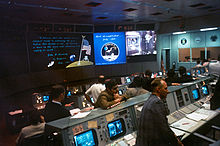
In 1961, as plans for Project Gemini began, it became increasingly clear that the Mercury Control Center located at the Cape Canaveral Air Force Station launch center would become inadequate to control missions with maneuverable spacecraft such as Gemini and Apollo. Christopher Kraft and three other flight controllers began studying what was needed for an improved control center, and directed a study contract awarded to Philco's Western Development Laboratory. Philco bid on and won the contract to build the electronic equipment for the new Mission Control Center, which would be located in Building 30 of MSC rather than Canaveral or the Goddard Space Flight Center in Maryland. Construction began in 1963.[20]
The new center had two Mission Operations Control Rooms, allowing training and preparation for a later mission to be carried out while a live mission is in progress. It was brought online for testing purposes during the uncrewed Gemini 2 flight in January 1965[21] and the first crewed Gemini flight, Gemini 3 in March 1965, though the Mercury Control Center still retained primary responsibility for control of these flights. It became fully operational for the flight of Gemini 4 the following June, and has been the primary flight control center for all subsequent U.S. crewed space missions from Project Gemini forward.[12][13]
NASA named the center the Christopher C. Kraft Jr. Mission Control Center on April 14, 2011.[22]
Apollo program
[edit]In addition to housing NASA's astronaut operations, JSC is also the site of the former Lunar Receiving Laboratory, where the first astronauts returning from the Moon were quarantined, and where the majority of lunar samples are stored. The center's Landing and Recovery Division operated MV Retriever in the Gulf of Mexico for Gemini and Apollo astronauts to practice water egress after splashdown.[citation needed]
On February 19, 1973, four weeks after Johnson's death, President Richard Nixon signed into law a Senate resolution renaming the Manned Spacecraft Center in his honor. As Senate Majority Leader, Johnson had sponsored the 1958 legislation which created NASA;[23][24] dedication ceremonies were held six months later on August 27.[25]
One of the artifacts displayed at Johnson Space Center is the Saturn V rocket. It is whole, except for the ring between the S-IC and S-II stages, and the fairing between the S-II and S-IVB stages, and made of actual surplus flight-ready articles. It also has real (though incomplete) Apollo command and service modules, intended to fly in the canceled Apollo 19 mission.[citation needed]
In June 2019, the restored Apollo Mission Control Center was opened for tourists.[26]
Space Shuttle program
[edit]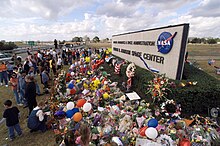
In the wake of the January 28, 1986, Space Shuttle Challenger disaster, President Ronald Reagan and First Lady Nancy Reagan traveled to JSC on January 31 to speak at a memorial service honoring the astronauts. It was attended by 6,000 NASA employees and 4,000 guests, as well as by the families of the crew. During the ceremony, an Air Force band led the singing of "God Bless America" as NASA T-38 Talon supersonic jets flew directly over the scene in the traditional missing-man formation. All activities were broadcast live by the national television and radio networks.[citation needed]
A similar memorial service was held at the Johnson Space Center on February 4, 2003, for the astronauts who perished in the Space Shuttle Columbia disaster three days before, which was attended by President George W. Bush and First Lady Laura Bush. Although that service was broadcast live by the national television and radio networks, it was geared mainly to NASA employees and the families of the astronauts. A second service for the nation was led by Vice-President Dick Cheney and his wife Lynne at Washington National Cathedral two days later.[27]
On September 13, 2008, Hurricane Ike hit Galveston as a category 2 hurricane and caused minor damage to the Mission Control Center and other buildings at JSC.[28] The storm damaged the roofs of several hangars for the T-38 Talons at Ellington Field.[28]
Facilities
[edit]The Johnson Space Center is home to Christopher C. Kraft Jr. Mission Control Center (MCC-H), the NASA control center that coordinates and monitors all human spaceflight for the United States. MCC-H directed all Space Shuttle missions, and currently directs American activities aboard the International Space Station. The Apollo Mission Control Center, a National Historic Landmark, is in Building 30. From the moment a crewed spacecraft clears its launch tower until it lands back on Earth, it is in the hands of Mission Control. The MCC houses several Flight Control Rooms, from which flight controllers coordinate and monitor the spaceflights. The rooms have many computer resources to monitor, command, and communicate with spacecraft. When a mission is underway, the rooms are staffed around the clock, usually in three shifts.[citation needed]
JSC handles most of the planning and training of the U.S. astronaut corps and houses training facilities such as the Sonny Carter Training Facility and the Neutral Buoyancy Laboratory, a critical component in training astronauts for spacewalks. The Neutral Buoyancy Laboratory provides a controlled neutral buoyancy environment—a very large pool containing about 6.2 million U.S. gallons (23,000 m3) of water where astronauts train to practice extra-vehicular activity tasks while simulating zero-g conditions.[29][30] The facility provides preflight training in becoming familiar with crew activities and with the dynamics of body motion under weightless conditions.[31]
Building 31-N houses the Lunar Sample Laboratory Facility, which stores, analyzes, and processes most of the samples returned from the Moon during the Apollo program.[citation needed]
The center is also responsible for direction of operations at White Sands Test Facility in New Mexico, which served as a backup Space Shuttle landing site and would have been the coordinating facility for the Constellation program, which was planned to replace the Shuttle program after 2010, but was canceled in 2009.[citation needed]
The visitor center has been the adjacent Space Center Houston since 1994; JSC Building 2 previously housed the visitor center.[citation needed]
The Johnson Space Center Heliport (FAA LID: 72TX) is located on the campus.[32]
Personnel and training
[edit]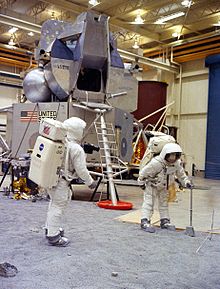

About 3,200 civil servants, including 110 astronauts, are employed at Johnson Space Center. The bulk of the workforce consists of over 11,000 contractors. As of October 2014, Stinger Ghaffarian Technologies took over United Space Alliance's primary contract.[33] As of June 2021,[update] the center's director is Vanessa E. Wyche.[citation needed]
NASA's astronaut training is conducted at the Johnson Space Center. Astronaut candidates receive training on spacecraft systems and in basic sciences including mathematics, guidance and navigation, oceanography, orbital dynamics, astronomy, and physics.[31] Candidates are required to complete military water survival prior to beginning their flying instruction. Candidates are also required to become scuba-qualified for extravehicular training and are required to pass a swimming test.[34][35] EVA training is conducted at the Sonny Carter Training Facility. Candidates are also trained to deal with emergencies associated with hyperbaric and hypobaric atmospheric pressures and are given exposure to the microgravity of space flight.[31] Candidates maintain their flying proficiency by flying 15 hours per month in NASA's fleet of T-38 jets based at nearby Ellington Field.[36]
Research
[edit]Johnson Space Center leads NASA's human spaceflight-related scientific and medical research programs. Technologies developed for spaceflight are now in use in many areas of medicine, energy, transportation, agriculture, communications, and electronics.[37]
The Astromaterials Research and Exploration Science (ARES) office performs the physical science research at the center. ARES directs and manages all functions and activities of the ARES scientists who perform basic research in earth, planetary, and space sciences. ARES scientists and engineers provide support to the human and robotic spaceflight programs. The responsibilities of ARES also include interaction with the Office of Safety and Mission Assurance and the Human Space Flight Programs[broken anchor].[38]
Johnson Space Center was granted a five-year, $120-million extension of its agreement with the National Space Biomedical Research Institute at Baylor College of Medicine to study the health risks related to long-duration space flight. The extension will allow a continuation of biomedical research in support of a long-term human presence in space started by the institute and NASA's Human Research Program through 2012.[39]
The Prebreathe Reduction Program is a research study program at the JSC that is currently being developed to improve the safety and efficiency of space walks from the International Space Station.[40]
The Overset Grid-Flow software was developed at Johnson Space Center in collaboration with NASA Ames Research Center. The software simulates fluid flow around solid bodies using computational fluid dynamics.[citation needed]
The Texas Space Commission was established by Texas governor Greg Abbott on March 26, 2024 at Johnson Space Center.[41]
Memorial Grove
[edit]Astronauts, center directors, and other NASA employees are memorialized in a Memorial Grove near the main entrance and visitor badging center (building 110). Trees dedicated to the memory of astronauts and center directors are in a round cluster closest to the entrance, other employees are memorialized behind along a road on the facility leading to the main entrance.[42][43]
Space Shuttle retirement
[edit]JSC put in a bid to display one of the retired Space Shuttle orbiters, but was not selected.[44]
Gallery
[edit]-
A 2010 photo of JSC from the International Space Station
-
Space Shuttle Challenger atop its Shuttle Carrier Aircraft over JSC in 1983
-
Mission Control Center in 2005
-
Shuttle simulator in Building 9 in 2006
-
Aerial view of the complex from 2.000 feet, c 1989
See also
[edit]References
[edit]- ^ a b Grimwood (1963), p. 152.
- ^ Murray & Bly Cox (1989), pp. 33–35.
- ^ Dethloff (1993), p. 36.
- ^ a b "JSC History". Retrieved March 25, 2008.
- ^ a b Dethloff (1993), p. 38.
- ^ a b Swenson, Loyd S. Jr.; Grimwood, James M.; Alexander, Charles C. (1989). "Chapter 12.3: Space Task Group Gets a New Home and Name". This New Ocean: A History of Project Mercury. Special Publication. Vol. 4201. NASA. Archived from the original on July 13, 2009. Retrieved June 1, 2011.
- ^ a b Dethloff (1993), p. 39.
- ^ Korsgaard, Sean (July 20, 2019). "Williamsburg recalls watching Apollo 11 and helping crew get there". Virginia Gazette, Daily Press. Tribune Media. Archived from the original on July 24, 2019. Retrieved July 24, 2019.
- ^ a b Dethloff (1993), p. 40.
- ^ Dethloff (1993), pp. 41–42.
- ^ "Houston, we have a space program". Archived from the original on January 6, 2017. Retrieved October 12, 2015.
- ^ a b Schulman, Bruce J. (1994). From Cotton Belt to Sunbelt: Federal Policy, Economic Development, and the Transformation of the South 1938–1980. Duke University Press. p. 149. ISBN 978-0-8223-1537-7.
- ^ a b Dumoulin (1988).
- ^ "Space" is our product. // Aviation Week & Space Technology, June 17, 1963, v. 78, no. 24, p. 127.
- ^ Dethloff (1993), p. 48.
- ^ Swenson; Grimwood; Alexander (1989). "Appendix C: Organization Charts". This New Ocean: A History of Project Mercury. Special Publication. Vol. 4201. NASA.
- ^ John F. Kennedy, "Address at Rice University on the Nation's Space Effort" Archived May 6, 2010, at the Wayback Machine
- ^ "Charles Luckman Biography". Loyola Marymount University. 2007. Archived from the original on October 13, 2008. Retrieved July 6, 2009.
- ^ "Lyndon B. Johnson Space Center". NASAFacts. JSC 04264 Rev D.
- ^ Dethloff (1993), pp. 85–86.
- ^ Dethloff (1993), p. 85.
- ^ NASA - NASA Names Mission Control for Legendary Flight Director Christopher Kraft Archived April 13, 2020, at the Wayback Machine. Nasa.gov (2011-04-14). Retrieved on 2013-09-06.
- ^ Nixon (1973).
- ^ New York Times (1973).
- ^ "Space center dedication held". Victoria Advocate. (Texas). Associated Press. August 28, 1973. p. 1A.
- ^ Brown, David W. (June 29, 2019). "NASA Reopens Apollo Mission Control Room That Once Landed Men on Moon". The New York Times. ISSN 0362-4331. Retrieved July 1, 2019.
- ^ Woodruff, Judy (February 6, 2003). "CNN LIVE EVENT/SPECIAL: Remembering the Columbia 7: Washington National Cathedral Memorial for Astronauts". CNN. Retrieved September 15, 2011.
- ^ a b Frank Morring Jr. (September 16, 2008). "Ike Damage To NASA-JSC Light". Aviation Week. Retrieved October 18, 2009.[permanent dead link]
- ^ Strauss S (July 2008). "Space medicine at the NASA-JSC, neutral buoyancy laboratory". Aviat Space Environ Med. 79 (7): 732–3. PMID 18619137.
- ^ Strauss S, Krog RL, Feiveson AH (May 2005). "Extravehicular mobility unit training and astronaut injuries". Aviat Space Environ Med. 76 (5): 469–74. PMID 15892545. Retrieved August 27, 2008.
- ^ a b c NASA. "Astronaut Selection and Training". Archived from the original on April 27, 1999. Retrieved August 27, 2008.
- ^ "AirNav: 72TX - Johnson Space Center Heliport".
- ^ "NASA Awards Mission Operations Support Contract". NASA.gov. NASA. July 14, 2014.
- ^ Fitzpatrick DT, Conkin J (2003). "Improved pulmonary function in working divers breathing nitrox at shallow depths". Undersea Hyperb Med Abstract. 30 (Supplement): 763–7. PMID 12862332. Archived from the original on August 11, 2011. Retrieved August 27, 2008.
{{cite journal}}: CS1 maint: unfit URL (link) - ^ Fitzpatrick DT, Conkin J (July 2003). "Improved pulmonary function in working divers breathing nitrox at shallow depths". Aviat Space Environ Med. 74 (7): 763–7. PMID 12862332. Retrieved August 27, 2008.
- ^ Siceloff, Steven (April 20, 2011). "T-38s Soar as Spaceflight Trainers". NASA. Archived from the original on April 27, 2011. Retrieved August 10, 2021.
- ^ NASA. Johnson Space Center: Exploring the science of space for the future of Earth (PDF) (Report). NASA. Archived from the original (PDF) on April 10, 2020. Retrieved August 27, 2008.
- ^ "Astromaterials Research Office". Johnson Space Center. Archived from the original on October 10, 2009. Retrieved October 18, 2009.
- ^ "Johnson Space Center to continue biomedical research". Houston Business Journal. October 2, 2007. Retrieved October 18, 2009.
- ^ "Comparison of V-4 and V-5 Exercise/Oxygen Prebreathe Protocols to Support Extravehicular Activity in Microgravity". NASA Technical Reports. Retrieved October 18, 2009.
- ^ "Gov. Greg Abbott announces launch of Texas Space Commission at Johnson Space Center in Houston". khou.com. March 26, 2024. Retrieved March 27, 2024.
- ^ "Memorial Grove Map". NASA. Archived from the original on March 5, 2017. Retrieved July 19, 2016.
- ^ "Memorial Trees - Starport". starport.jsc.nasa.gov. January 4, 2022.
- ^ Berger, Eric. "Houston we've had a problem: 'Space City' snubbed in bid for retired space shuttle". Houston Chronicle. Archived from the original on April 17, 2011. Retrieved April 12, 2011.
Further reading
[edit]- Dethloff, Henry C. (1993). "Chapter 3: Houston - Texas - U.S.A.". Suddenly Tomorrow Came ... A History of the Johnson Space Center. National Aeronautics and Space Administration. ISBN 978-1502753588.
- Dumoulin, Jim (1988). "LYNDON B. JOHNSON SPACE CENTER". NSTS Shuttle Reference Manual. NASA: Kennedy Space Center. Archived from the original on January 14, 2012. Retrieved January 19, 2010.
- Grimwood, James M. (1963). "PART III (A) Operational Phase of Project Mercury, May 5, 1961 through May 1962". Project Mercury: A Chronology. Special Publication. Vol. 4001. Washington D.C.: NASA. p. 152.
- Murray, Charles; Bly Cox, Catherine (1989). Apollo: The Race to the Moon. New York: Simon and Schuster. ISBN 0-671-61101-1.
- New York Times (February 20, 1973). "Houston Space Center Is Named for Johnson". The New York Times. p. 19.
- Nixon, Richard M. (February 19, 1973). "50 – Statement About Signing a Bill Designating the Manned Spacecraft Center in Houston, Texas, as the Lyndon B. Johnson Space Center". Retrieved July 9, 2011.
External links
[edit]- Lyndon B. Johnson Space Center
- Suddenly, tomorrow came... A history of the Johnson Space Center (PDF format) 1993
- JSC Celebrates 40 Years of Human Space Flight September 2001 Archived November 29, 2021, at the Wayback Machine
- Roundup, official newsletter Roundup archive 1961-2001 Roundup archive 2003-present
- NASA Johnson Space Center Oral History Project – Interview with Thomas W. 'Tommy' Holloway
- "America's Space Program: Exploring a New Frontier", a National Park Service Teaching with Historic Places (TwHP) lesson plan
- Aviation: From Sand Dunes to Sonic Booms, a National Park Service Discover Our Shared Heritage Travel Itinerary
- Mission Control Archive Footage
- Johnson Space Center
- Buildings of the United States government in Texas
- NASA facilities
- Buildings and structures in Houston
- Tourist attractions in Houston
- Space technology research institutes
- Economy of Houston
- 1961 establishments in Texas
- Lyndon B. Johnson
- Oral history
- Government buildings completed in 1961
- Apollo program facilities


